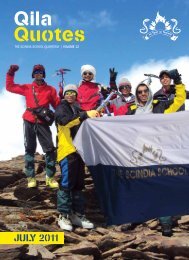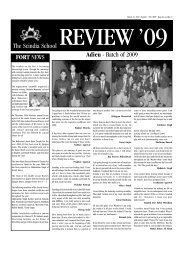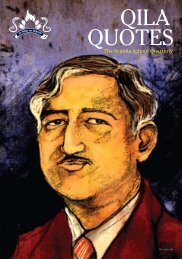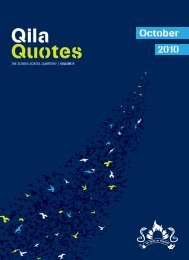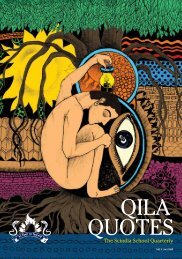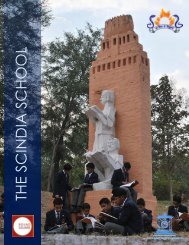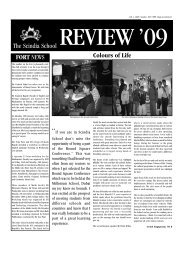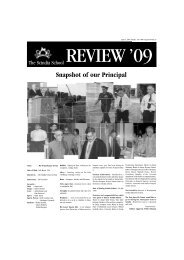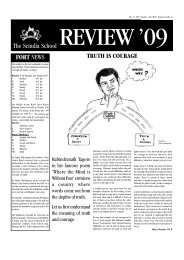31st July 2010 - The Scindia School
31st July 2010 - The Scindia School
31st July 2010 - The Scindia School
You also want an ePaper? Increase the reach of your titles
YUMPU automatically turns print PDFs into web optimized ePapers that Google loves.
Old Boys' News<br />
It is a matter of pride for all <strong>Scindia</strong>ns that Mr. Bharat Patel (Ex Md ’61) Board<br />
Member and Madhav Awardee (2005), has been appointed Advisor to the<br />
Chairman, Indian Premier League. We are certain that with Mr. Patel’s intervention<br />
the tournament will bring glory to the game of cricket in future.<br />
Rain water harvesting<br />
on Gwalior Fort<br />
Not many are aware of the engineering foresight that was shown by the rulers and military<br />
leaders of early 15th century when they conceived of and built the Gwalior Fort.<br />
Mr Bharat Patel (Ex Md ’61)<br />
HH Maharaja Jyotiraditya <strong>Scindia</strong> flagging<br />
off the car rally<br />
SOBA-North America Get together at New York<br />
09<br />
OLD BOYS'<br />
NEWS<br />
VOL 8 | Jul <strong>2010</strong><br />
A SOBA car rally took place from 2nd to 4th<br />
April, <strong>2010</strong>. On the 2nd, all the participants<br />
assembled at the National Sports Club of<br />
India, New Delhi. Car numbers, stickers, T-shirts,<br />
caps and rally kits were distributed. <strong>The</strong> rally<br />
was flagged off by HH Maharaja Jyotiraditya<br />
<strong>Scindia</strong>, Lt Gen SPS Dhillon, Mr. SK Rungta<br />
- Chairman SAIL, Mr. Bajoria (Ex-<strong>Scindia</strong>n) -<br />
Director JK Tyres and in charge of motor sports,<br />
and Tutu Dhawan- President FMSCI.<br />
All 62 cars reached Tarangi resorts at 5:30<br />
pm after a 345 Kms run through villages, dirt<br />
tracks and off beaten tracks. In the evening,<br />
the lawns of Tarangi witnessed a party where<br />
the results of the first day were announced.<br />
On the 3rd, the rally was flagged off from<br />
Tarangi at 9:00 am for a 99 Kms run in the<br />
hills with loops and teasers. It flagged down at<br />
Tarangi at 1:00 pm. <strong>The</strong> second day’s results<br />
were announced during the evening party. <strong>The</strong><br />
final results and prize distribution took place<br />
over drinks, dinner, music and dancing beside<br />
the river Kosi.<br />
Participants came from Gwalior, Jhansi,<br />
Dholpur, Agra, Jaipur, Moradabad, Kanpur and<br />
the NCR and were from the batches of 1955<br />
to 2009!<br />
Winners<br />
1st Mr. Rajeshwar Tyagi, Ex Ravindra ’65<br />
2nd Mr. Harmit Singh, Ex Md ’98<br />
3rd Mr. Pawan Bansal, Ex Je’73<br />
__________________________________<br />
SOBA- NA planned a Happy Hour Get Together<br />
on May 19th at the K Lounge in New York.<br />
Being close to a long weekend vacation, the<br />
turnout was modest. What made the evening<br />
more interesting was presence of Alumni of<br />
Daly College and Mayo College also.<br />
Just before breaking for the evening, SOBA<br />
Golf enthusiasts A Khanna and A Mandhle<br />
expressed keen interest to help host a SOBA/<br />
Pan Public Golf Outing in the summer in the<br />
New York / New Jersey area. Looking at the<br />
keen response to Golf in SOBA community in<br />
Delhi and also as a stir to keep the Pan Public<br />
Alumni mingling alive, this is an idea whose<br />
time is not too far off in the future!!<br />
__________________________________<br />
Yatin Singhal(Ex Rn’07) who went on a<br />
100% scholarship to Westminster University,<br />
London to pursue a course in Biotechnology<br />
has passed out with a first class degree.<br />
He is now joining the internationally<br />
renowned pharmaceutical company Novartis<br />
Pharmaceuticals in Liverpool, U.K.<br />
__________________________________<br />
Yatin Singhal (Ex Rn ’07)<br />
Not many are aware of the engineering<br />
foresight that was shown by the rulers and<br />
military leaders of early 15th century when<br />
they conceived of and built the Gwalior Fort.<br />
<strong>The</strong> location of the Fort is unique in that it is<br />
located on a 100 metre high hill that overlooks<br />
and dominates the main route from the North<br />
Indian plains to Central India and further South<br />
to the Deccan Plateau.<br />
Interestingly enough Gwalior Fort was not<br />
built where there was a river, like the Forts at<br />
Agra or Delhi or elsewhere, but where military<br />
needs dictated. It is also clear that water is<br />
one commodity that cannot be created and<br />
humanity cannot live without it. A Fort would<br />
need water to sustain its troops and other<br />
people. <strong>The</strong> then rulers were well aware of the<br />
existence of Suraj Kund, an 8th century water<br />
tank on top of this strategically located hill.<br />
It was after drinking the water from this tank<br />
that the Rajput chieftain, Suraj Sen or Suraj<br />
Pal, is believed to have been cured of a deadly<br />
disease on the advice of Saint Gwalipa, after<br />
whom Gwalior city is named. <strong>The</strong> presence<br />
of Suraj Kund, with its perennial supply of<br />
water, may have encouraged the then rulers<br />
to consider the construction of Gwalior Fort<br />
on top of this hill with its location providing a<br />
strategic advantage.<br />
<strong>The</strong> beloved Fort- we want to keep it green<br />
Numerous water tanks of the Fort were<br />
built of a size and at a location that they<br />
remained perennial sources of water. <strong>The</strong> water<br />
availability in these ‘taals’ was estimated to<br />
cater to 15,000 persons living inside the Fort.<br />
I still recall with nostalgia names of the various<br />
‘taals’ on the Fort – Suraj Kund, Singhara Taal,<br />
Khamba Taal, Jauhar Tank near Gurjari Mahal,<br />
Gangola Taal, Rani Taal, Cheri Taal and Dhobi<br />
Taal, to name a few!<br />
<strong>The</strong> designers of these ‘taals’ simply used the<br />
ancient wisdom of collecting rainwater during<br />
the monsoons and using it for the entire<br />
year. It should be remembered that it is not<br />
feasible for armies to be located inside any<br />
Fort for taking up defence and yet to remain<br />
dependent on water from outside sources.<br />
At Gwalior Fort the problem was even more<br />
acute due to its height above the surrounding<br />
areas. <strong>The</strong>re was no ground water that one<br />
could turn to. One was entirely dependent on<br />
collection, storage and judicious use of the<br />
rain water that fell during the rainy season. <strong>The</strong><br />
‘taals’ have been designed to hold water and<br />
not charge the aquifer, as happens in case of<br />
check dams or ‘johads’.<br />
Gwalior has an average of 88-90 cm of rain<br />
every year. <strong>The</strong> skill lies in making sure that<br />
this rain water does not run off and get wasted.<br />
Thus one needed to have well prepared<br />
catchments which would funnel the water into<br />
the tanks made at selected sites. Unfortunately,<br />
at present many of these catchments around<br />
the ‘taals’ have been encroached upon thus<br />
reducing the catchment surface areas. <strong>The</strong><br />
preservation and use of this water was the<br />
second problem. Note how the ‘taals’ in the<br />
Fort are all lined water tanks. <strong>The</strong>se lined tanks<br />
prevent loss of water due to seepage and are<br />
easy to clean during the dry season just before<br />
the monsoons.<br />
Gwalior Fort provides the<br />
very best example of what<br />
the country can emulate<br />
for enriching their water<br />
availability through rain<br />
water harvesting.<br />
By Atul Dev<br />
Ex Md ’55<br />
(Atul Dev is currently a very active Rotarian who<br />
is involved with a series of water harvesting<br />
projects in Rajasthan.)<br />
10 Alumni<br />
VOL 8 | Jul <strong>2010</strong>





